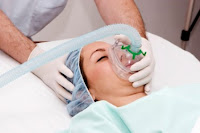Back to the basics!!! Safe conduct of anaesthesia should be the priority when surgical cases are posted for procedures.The expertise and experience of the anaesthetist along with proper monitoring are essential in achieving this goal, but without considering the basics of anaesthesia practise even an experienced physician backed up by all essential monitors may turn to be a dangerous anaesthetist. Here are the ten golden rules of anaesthesia which stand immortal even in the midst of recent advances.
1.Assess and prepare the patient adequately:So that you will not anaesthetise anyone with multisystem disorders, heart disease,anemia or metabolic disorders.The physician should get sufficient information about the medications the patient is receiving as the drug interaction of these drugs with anaesthetic agents are complex and sometimes dangerous.Prepare the patient by correcting dehydration, severe anaemia,diabetes, heart failure,hyperthyroidism etc..Identifying pre existing diseases and correcting them help the anaesthetist for proper risk stratification of cases and a proper plan of anaesthesia technique can be made.The detailed explanation of the anaesthesia procedure must be offered to the patient and an informed consent must be obtained.
2.Starve the patient even for local anaesthesia: So that if the patient tries to vomit his stomach is less likely to be full. In case the local anaesthesia fails or a toxicity or CNS involvement by the local anaesthetics he may have to administer general anaesthesia or to resuscitate the patient.
3.Anaesthetise him on a tipping table: Because he may still vomit ,even if he is supposed to have been starved.So you must be able to tip him head down.If you do this, the chance of aspiration (even if he regurgitates)is very less.
4.Check your drugs and equipment: Before your start,especially if you are using less simple equipment. The equipment to preserve his airway must be ready beside you.All drugs including drugs for emergency use must be loaded and labelled.The anaesthesia machine and monitors should be checked as per routine checking protocols.
5.Keep a sucker instantly ready: Tested and working,so that if his pharynx fills with vomit,you can suck it out.You will also need suction catheters.A properly working suction catheter is mandatory for administering anaesthesia.
6.Keep airway clear: Because it can be easily obstructed.One way to do this is to use a Guedel's airway.You will need a range of different sizes. Alternatively you can use the triple manuevour too. Recently with the introduction of LMAs the airway management has become simpler and easier.
7.If the patient needs ventilation: Have a self inflating bag, non re breathing valve,and a face mask ready.You may need to intubate the patient.Have access to laryngoscope, tracheal tubes,an introducer and suction catheters.Intubation is the only way you can be sure to control his airway and prevent aspiration.
8.Have a vein open: Because if the patient has a drip,or an indwelling needle you can treat some of the complications ,that may arise during anaesthesia more easily, and give him both blood and fluids quickly.An open vein is an essential precaution in all major operations.
9.Monitor pulse and blood pressure: Continually during the operation and immediately after it,so that you are able to take the the necessary corrective action before it is too late.You must recognise cardiac arrest immediately.One of the most effective ways to do this is to strap a precordial stethescope to his chest and listen to the sounds.(we have advanced to the level of TEE now)
10.Always have someone in the room who can apply cricoid pressure: Some body who is experinced in giving cricoid pressure effectively must be available in the operating room.He should be either a second anaesthetist or a nurse anaesthetist.The practise is useful in emergency and to anaesthetise full stomach patients.Now the practise of cricoid pressure is a controversial issue as some physicians believe it will do more harm than good .They argue that the pharyngeal stimulation may result in regurgitation and it is difficult to estimate the required pressure.Also placement of LMA is difficult and chance of tracheal cartilage injury is high..
These Golden rules were published in the beginning of anaesthesia practise aiming to help the anaesthetist to deliver safe anaesthesia but many of the rules stated are applicable to modern days of practise as well..The anaesthesiologist should not forget the directive primum non nocere (“first of all do no harm”) and should always observe the basics, guidelines and protocols in spite of advanced monitoring.Let us remember the saying
‘Provide good care with very few monitors’
‘More monitoring, however does not necessarily lead to better care’
‘No monitor can ever replace a human being as he has the 6th sense.’
‘The focus of attention for greater part of the time should be on the patient and the operation, not on monitors.’
- Wendell C. Stevens
Ref: 1) Primary Anaesthesia Edited by Maurice King, Oxford University Press 1992


















4 comments:
Hello Sir,
Thanks for sharing this anaesthesia today post. Here you have mentioned anaesthesia procedures.
Anaesthesia Products
Agree with all...but wonder re no 10 - what is the evidence for cricoid pressure? And is there not evidence that even when appropriately applied, oesophageal occlusion does not occur?
Hi. I don't quite understand why you put so much emphasis on regurgitation of gastric content which, if anesthesia is conducted proficiently, is a rare event.
I prefer other golden rules:
1) trust nobody
2) assume nothing
3) give oxygen
4) blood goes round and round and air goes in and out. Make it stay that way.
5) for elderly patients: start low, go slow and take it easy
6) never get yourself into a s***t you wouldn't know how to get out of
Measure the brain (BIS/EMG)
Preempt the pain (ketamine 50 mg 3 min pre-stimulation)
Emetic drugs abstain (no opioids or inhalational agents)
Lowest PONV rate (0.6%) in literature in high risk group (Apfel C: Postoperative Nausea and Vomiting chapter in Miller’s Anesthesia, 7th ed. Philadelphia, PA, Elsevier 2010; p 2743. (2729-59).
Post a Comment